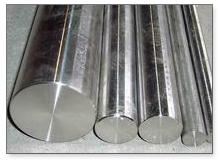
440C Stainless Steel is a martensitic grade of stainless steel that provides very good wear resistance combined with moderate corrosion resistance in mild environments. 440C is heat treatable to RC 59. This grade is commonly used in cutlery and food processing applications.
440C Stainless steel is a type of modern steel and famous for its high corrosion resistant, wear resistance, strength and hardness qualities among all the stainless alloys, capable of attaining (after heat treatment) the highest hardness (60 HRC). It has good resistance to the atmosphere, fresh water and mild acids. It has best resistance in the hardened, tempered and passivated condition. It allows creating a smooth polished surface and Razor sharp edges. It is being used in cutting instruments, rolling element bearings, valve seats, high quality knife blades, surgical instruments, chisels, ball bearings and valve parts and most commonly used in the production of Cutting tools, including Haircutting Scissors, daggers and swords.
Grades 440A and 440B are identical except for slightly lower carbon contents (0.60 - 0.75% and 0.75 - 0.95% respectively), they attain lower hardness but slightly higher corrosion resistances. Although all three versions of this grade are standard grades, in practice 440C is more available than the A or B variants. Another alloy 440F (UNS S44020) also exists, with the same high carbon content as 440C.
| Chemical |
Composition |
| Carbon |
1.00 % |
| Manganese |
.50% |
| Chromium |
17.50% |
| Silicon |
.35% |
| Molybdenum |
.50% |
Chemical Composition ranges of 440C Stainless Steel:
| Ingredients |
Min |
Max |
| Carbon |
0.95 |
1.20 |
| Manganese |
- |
- |
| Silicon |
1.00 |
|
| Phosphorus |
- |
0.040 |
| Sulphur |
- |
0.030 |
| Chromium |
16.00 |
18.00 |
| Molybdenum |
- |
0.75 |
Corrosion Resistance of 440C Stainless Steel:
440C stainless steel is characterized by good corrosion resistance in mild domestic and industrial environments, including fresh water, organic materials, mild acids, various petroleum products. 440C also provides extreme high strength, hardness and wear resistance when in the hardened and tempered condition.
Thermal Treatments:
- Preheat: Optional preheat stage for unbalanced geometries or complex designs - 1100/1250F (590/675C), equalize, standard preheat stage - 1400/1500F (760/815C), equalize.
- Austenize: 1850/1900F (1010/1020C), equalize, 30/45 minutes at temperature.
- Quench: Air, positive pressure vacuum to below 125F (50C)(2 bar minimum). Interrupted oil to below 1000F (540C). Air cool to 150F (65C). Temper immediately.
- Temper: 400/800F (205/425C), hold 2 hours at temperature, air cool. Temper twice. Avoid tempering between 800 and 1100F, due to a decrease in toughness and corrosion resistance.
- Cryogenic Treating: Refrigeration treatments may improve long term dimensional stability by transforming retained austenite. Refrigeration treatments should generally be performed after the first temper, and must be followed by a temper
Hardness and Impact Toughness Data air cooled from 1885F(1030C)Tempering Temperature:
| Deg.F |
Deg.C |
HRC |
| As quenched |
|
59 |
| 212 |
100 |
59 |
| 400 |
205 |
56 |
| 600 |
315 |
54 |
| 800 |
425 |
55 |
| 1000 |
540 |
51 |
- Surface Treatments: Nitriding decreases the corrosion resistance of stainless steels and is generally not recommended for stainless steels.
- Annealing: A. Heat to 1650F (870C), hold 2 hours, slow cool 25F (15C)/hour maximum) to 1200F (650C), air cool. B. Heat to 1600F(870C), hold 2 hours, cool to 1300F (760C), hold 4 hours, air cool
Typical Annealed Hardness: 215/255 BHN:
- Stress Relieving: Annealed Material – Heat to 1200/1250F(650/675C), hold two hours, cool in still air.
- Hardened Material: Heat to 25F (15C) below original tempering temperature, hold two hours, cool in still air.
- Welding: Use 440C or 420 stainless steel filler material. Annealed Material: Preheat 600/800F(320/430C), maintain over 600F(320C) during welding. Reanneal or temper 1200/1400F(650/760C) for 4 hours after welding.
- Hardened Material: Preheat to 50F (30C) below original tempering temperature (400F (205C) minimum). Maintain above 400F (205C) during welding. Cool to 150F (65C) after welding. Temper immediately 25F (15C) below original tempering temperature. Minimum 400F(205C)
Physical Properties:
- Modulus of Elasticity: 30psix10(6) (200 GPa)
- Density: 0.278 lb/in3 (7640 kg/M3)
- Thermal Conductivity: 14.0 BTU/hr./ft./F 24.2 W/m/ °K)
Physical properties for grade 440 stainless steels:
| Grade |
Density (kg/m3) |
Elastic Modulus (GPa) |
Mean Coefficient of Thermal Expansion (mm/m/C) |
Thermal Conductivity (W/m.K) |
Specific Heat
0-100C (J/kg.K) |
Electrical Resistivity (nW.m) |
| |
|
|
0-100C |
0-200C |
0-600C |
at 100C |
at 500C |
440
A/B/C |
7650 |
200 |
10.1 |
10.3 |
11.7 |
24.2 |
- |
460 |
600 |
Machining:
In the annealed condition this grade is relatively easily machined; approximately the same as for high speed steel. If this grade is hardened machining becomes very difficult and probably impossible.